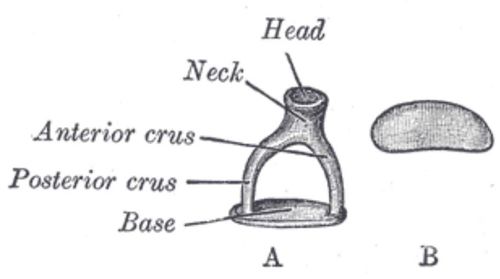Stapes bone: Difference between revisions
Ahmed Samir (talk | contribs) No edit summary |
Kim Jackson (talk | contribs) No edit summary |
||
| Line 1: | Line 1: | ||
'''Original Editor '''- | <div class="editorbox"> '''Original Editor '''- [[User:User Name|User Name]] '''Top Contributors''' - {{Special:Contributors/{{FULLPAGENAME}}}}</div> | ||
'''Top Contributors''' - {{Special:Contributors/{{FULLPAGENAME}}}} | |||
== Introduction == | == Introduction == | ||
[[File:Stapes_Bone.jpg|thumb|500x500px|'''''Structure of stapes bone.''''']] | [[File:Stapes_Bone.jpg|thumb|500x500px|'''''Structure of stapes bone.''''']] | ||
Revision as of 18:53, 16 February 2020
Introduction[edit | edit source]
Stapes bone is the smallest bone in our body. It is the innermost bone of our auditory ossicles in the middle ear, which are responsible for transmitting sound waves from the air outside to the fluid-filled labyrinth (cochlea). Auditory ossicles are a group of three small bones that work together forming a vibrating chain. These three bones are as follows:
- Malleus
- Incus
- Stapes
Related Conditions[edit | edit source]
- Otosclerosis
- Stapedectomy[3]
Related Articles[edit | edit source]
References[edit | edit source]
- ↑ BBC - The smallest Bones in your body:https://www.youtube.com/watch?v=AsPtiV8NkaU&t=1s
- ↑ Ear Ossicles: https://www.youtube.com/watch?v=pMNpEO2D4gk&t=8s
- ↑ Stapedectomy article on Wikipedia: https://en.wikipedia.org/wiki/Stapedectomy







